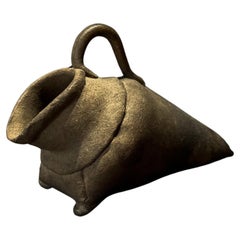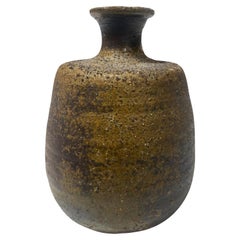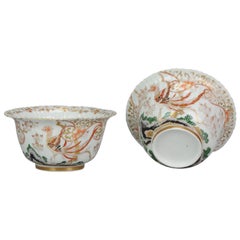House of Huseth Ceramics
to
1
1
1
1
1
1
1
1
1
1
1
Antique Pigeon Sake Bottle, Edo Period from Japan
Located in Asheville, NC
This antique 'pigeon' sake bottle is from the Edo period (1603-1868). It is ceramic and in perfect condition with an incredible patina. Has a tan, slight olive color tone to it.
Category
Antique Early 19th Century Japanese Ceramics
Materials
Ceramic
Related Items
Kaneshige Toyo National Treasure Signed Japanese Bizen Pottery Sake Bottle Vase
Located in Studio City, CA
A beautiful, perfectly shaped and balanced antique Bizen ware shibui sake bottle (tokkuri) vase by renowned Japanese master potter/artist Kaneshige Toyo (1896-1967) featuring a unique natural, wonderfully textured organic forming ash glaze. Kaneshige is universally considered to be the founder of modern Bizen pottery.
In 1956, Kaneshige was certified as a Living National Treasure (Important Intangible Cultural Heritage) for his work in Bizen Ware pottery/ceramics. Bizen Ware is a type of Japanese pottery traditionally from the Bizen province, presently a part of the Okayama prefecture. It is considered one of the Six Ancient Japanese Kilns (along with Echizen ware, Seto ware, Shigaraki ware, Tamba ware, and Tokoname ware).
The piece is signed/ sealed on the base with one of Kaneshige's traditional incised marks.
A rather striking and engaging work. One of the best Kaneshige works we have come across. Scarce and hard to find in such an excellent condition. Would be a fantastic addition to any Japanese/Asian pottery or Bizen Ware collection or eye-catching stand-alone work in about any setting.
Kaneshige's work can be found in numerous prominent collections and museums including:
Aichi Prefectural Ceramic Museum, Seto, Japan
Brooklyn Museum, NY
Hagi Uragami Museum, Yamaguchi, Japan
Honolulu Art Museum, HI
Ibaraki Ceramic Art Museum, Kasama, Japan
Indiana Art...
Category
Mid-20th Century Japanese Showa Ceramics
Materials
Stoneware
Pair Antique 18th C Japanese Imari Gold Bowl Japan Figure Edo Period
Located in Amsterdam, Noord Holland
Lobed and ribbed bowl with phoenix, flowering plants and floral scrolls. The ribbed wall and lobed edge, painted in overglaze enamels red, green and gold, black and grey/turqoise. Th...
Category
Antique 18th Century Japanese Edo Ceramics
Materials
Porcelain
Japanese Meiji Period Early 20th Century Sake Bottle with Brown Patina
Located in Yonkers, NY
An antique Japanese Meiji period monochrome sake bottle from the early 20th century with concentric lines. Created in Japan during the Meiji period, this antique sake bottle captivat...
Category
Early 20th Century Japanese Meiji Bottles
Materials
Ceramic
Ko-Imari Edo Period Japanese Porcelain Plate Antique Blue White 17th c
Located in Amsterdam, Noord Holland
A rare porcelain dish, Arita Kilns. Superb decoration.
Condition
Overall Condition; 1 chip with a Silver ot Tin repair. Measures: 148mm x 27mm
Perio...
Category
Antique 17th Century Chinese Edo Ceramics
Materials
Porcelain
Japan, a Late 18th Century Imari Charger, Edo Period
Located in PARIS, FR
Nice hand painted Porcelain charger in the Imari palette using underglaze cobalt bleu and iron red.
Japan, Edo period, late 18th century.
Category
Antique Late 18th Century Japanese Ceramics
Materials
Porcelain
Antique Japanese Enamel Bronze Vase, Japan, Edo or Meiji Period
Located in Amsterdam, Noord Holland
Unmarked. Japan, 19th century. Provenance: collection Nieuwenhove.
Inventory number at the base.
Condition
Minimal ware to enamel and some processing flaws. Size 300mm high
...
Category
Antique 19th Century Chinese Meiji Ceramics
Materials
Bronze
Antique 18th Century Japanese Garniture Porcelain Vase Imari Edo Period
Located in Amsterdam, Noord Holland
Amazing set for decorating your home. Interesting foo dogs/lions as handles on the lids. The have small holes in them.
Condition:
Lids; 2 with restored chip and in some chips ...
Category
Antique 18th Century Japanese Edo Ceramics
Materials
Porcelain
Japanese Chawan 'Teabowl' Edo Period
Located in Stockholm, SE
A Japanese Chawan. Glazed pottery. 19th century or older. Provenance: Swedish early 20th century collection.
Category
Antique 19th Century Japanese Ceramics
Materials
Ceramic
Ca 17th C Japanese Ko-Imari Porcelain Edo Period Dish Antique Japan
Located in Amsterdam, Noord Holland
Description
Sharing with you a very nice example of the Edo period with a gentle scene of a bird in flight looking down on a garden scene with what seems to be a pot.
Condition...
Category
Antique 17th Century Japanese Ceramics
Materials
Porcelain
Antique Kraak Edo Period 1680-1690 Japanese Porcelain Huge Charger Arita
Located in Amsterdam, Noord Holland
Sharing with you this very nice edo period, 1680-1700, example. With a garden floral scene.
Marked at base:
made in the Hua Qing period of the great Ming Dynasty
Arita ware, also known as Arita-yaki, has its origins in 1616, when a Korean farmer, Yi Sam-pyeong, discovered white clay kaolin in Arita and used it to create Japan’s first porcelain. Arita was the first place to produce ceramics in Japan. After the discovery, a number of kilns opened in the area and it soon became a source for Japanese export porcelain...
Category
Antique 17th Century Japanese Edo Ceramics
Materials
Porcelain
Antique Edo Period Japanese Aoki Mokubei Jar Japan Figures Trees
Located in Amsterdam, Noord Holland
Description
A Japanese Aoki Mokubei Jar. Edo Period. The inside base has a fish between the figures with gilt.
A very powerfull piece and in our opinion most likely authentic by Aoki Mokubei (????)
Mokubei AOKI (1767- July 2, 1833) was a painter and Kyo ware potter during the Edo Period . He was born in Kyoto . His childhood name was Yasoya. His Azana (alias) was Sahei. His pseudonyms included Seibei, Hyakurokusanjin, Kokikan, Teiunro, Kukurin, and Shubei.
Biography
Mokubei was born in 1767, in Kyoto . He studied calligraphy under Fuyo KO at a young age, showing great talent; however, when he found pottery, he opened a studio in Awataguchi, Kyoto at the age of 30 and won fame for his pottery. Five years later, he was invited by the Maeda Family of the Kaga clan, and he made efforts to revive Kaga Kutani ware. As a potter, he mainly produced green-tea sets. His pottery work is varied, including white porcelain, celadon, Akae ware (ceramic with red paintings) and dyed ceramics. As a result of his commitment to Chinese ceramics, he created a world of his own in making copies of Chinese ware...
Category
Antique 19th Century Japanese Edo Ceramics
Materials
Porcelain
Monumental Japanese Sake Vessel, c. 1850
Located in Chicago, IL
This elegant, large-scale vessel is a Japanese widemouth stoneware jar (kame) traditionally used for storing water and other liquids. This 19th-century example continues traditional ...
Category
Antique Mid-19th Century Japanese Meiji Ceramics
Materials
Porcelain, Stoneware


